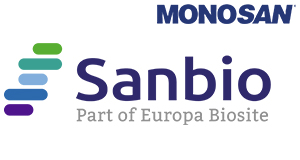Anti-DDX5 Antibody Picoband™ (monoclonal, 3F9)
Anti-DDX5 Antibody Picoband™ (monoclonal, 3F9)
SKU
SANMON23714
Packaging Unit
100μg
Manufacturer
Sanbio / Monosan
Availability:
loading...
Price is loading...
Clone Number: 3F9
Immunogen: E.coli-derived human DDX5 recombinant protein (Position: R85-K328).
Concentration: Adding 0.2 ml of distilled water =f 500 μg/ml.
Format: Lyophilized
Storage buffer: Each vial contains 4mg Trehalose, 0.9mg NaCl, 0.2mg Na2HPO4, 0.05mg NaN3.
Additional info: Store at -20˚C for one year from date of receipt. After reconstitution, at 4˚C for one month. It can also be aliquotted and stored frozen at -20˚C for six months. Avoid repeated freeze-thaw cycles.Add 0.2ml of distilled water will yield a concentration of 500ug/ml. Background: DDX5 (DEAD/H BOX 5), also known as HLR1 or G17P1, is an enzyme that in humans is encoded by the DDX5 gene. The p68 protein is a proliferation-associated nuclear antigen first identified through its highly specific cross-reaction with the simian virus 40 tumor antigen (Iggo et al., 1989). Subsequently, homology to eukaryotic translation initiation factor was found, and amino acid sequence blocks characteristic of a large superfamily of proteins with putative helicase activity were demonstrated. Brody et al. (1995) confirmed that this gene is located on chromosome 17 in the region of the BRCA1 gene at 17q21. By immunoprecipitation analysis, Caretti et al. (2006) found that p68, p72 (DDX17), and the noncoding RNA SRA (SRA1) associated with MYOD (MYOD1) in MYOD-transfected HeLa cells. Subcellular Localization: Nucleus. Spliceosome. Tissue Specificity:
Immunogen: E.coli-derived human DDX5 recombinant protein (Position: R85-K328).
Concentration: Adding 0.2 ml of distilled water =f 500 μg/ml.
Format: Lyophilized
Storage buffer: Each vial contains 4mg Trehalose, 0.9mg NaCl, 0.2mg Na2HPO4, 0.05mg NaN3.
Additional info: Store at -20˚C for one year from date of receipt. After reconstitution, at 4˚C for one month. It can also be aliquotted and stored frozen at -20˚C for six months. Avoid repeated freeze-thaw cycles.Add 0.2ml of distilled water will yield a concentration of 500ug/ml. Background: DDX5 (DEAD/H BOX 5), also known as HLR1 or G17P1, is an enzyme that in humans is encoded by the DDX5 gene. The p68 protein is a proliferation-associated nuclear antigen first identified through its highly specific cross-reaction with the simian virus 40 tumor antigen (Iggo et al., 1989). Subsequently, homology to eukaryotic translation initiation factor was found, and amino acid sequence blocks characteristic of a large superfamily of proteins with putative helicase activity were demonstrated. Brody et al. (1995) confirmed that this gene is located on chromosome 17 in the region of the BRCA1 gene at 17q21. By immunoprecipitation analysis, Caretti et al. (2006) found that p68, p72 (DDX17), and the noncoding RNA SRA (SRA1) associated with MYOD (MYOD1) in MYOD-transfected HeLa cells. Subcellular Localization: Nucleus. Spliceosome. Tissue Specificity:
| SKU | SANMON23714 |
|---|---|
| Manufacturer | Sanbio / Monosan |
| Manufacturer SKU | MON23714 |
| Package Unit | 100μg |
| Quantity Unit | STK |
| Reactivity | Human, Mouse (Murine), Rat (Rattus) |
| Clonality | Monoclonal |
| Application | Immunofluorescence, Immunohistochemistry (frozen), Western Blotting, Flow Cytometry, Immunohistochemistry, Immunocytochemistry |
| Isotype | IgG2b |
| Host | Mouse |
| Conjugate | Unconjugated |
| Product information (PDF) |
|
| MSDS (PDF) |
|

 Deutsch
Deutsch







